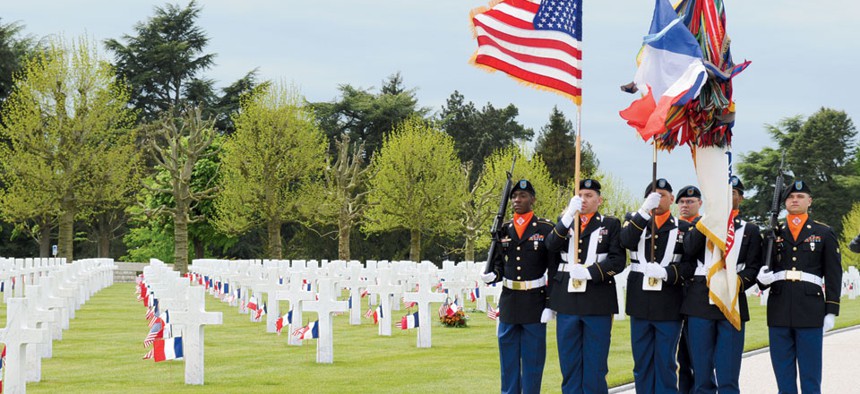
United States Army
An Allied Salute
American military tributes continue overseas long after two world wars.
Europe seems a world away to many of us, but during a visit in late May I found continuing affection for Americans and gratitude for what we have done over the past 100 years to preserve European liberty.
That sentiment is especially strong in regions like the Somme, north of Paris, where U.S. military cemeteries provide the final resting place for thousands of Americans who lost their lives in two world wars.
The World War I battlefields in northern France are not as well known today as those of World War II along the
Normandy coast. But they are as spare and elegant, with their long rows of white crosses and stars of David on meticulously kept green lawns. They exude a spirit of light and even optimism—as befits the cause for which we fought. “The hallowed graves here and at countless cemeteries worldwide remind us that freedom is not free,” said U.S. Army Brig. Gen. Bruce G. Crawford at a moving May 26 Memorial Day ceremony at the Somme American Cemetery. Crawford led a contingent of military personnel detailed to honor the American dead, traveling six hours from the American base in Wiesbaden, Germany.
The celebration at the cemetery in the town of Bony brought together an interestingly diverse cast of participants. A full French military band was present, with two dozen musicians. From Wiesbaden came a color guard of five men in dress uniform. On their own time, six other American soldiers in fatigues showed up from the storied 28th Infantry Regiment—the first U.S. detachment to see action in World War I, whose valor gave the allies confidence that brand-new troops could hold the line against the Germans. As if newly off the ancient battlefield was a cast of 15 re-enactors—French men and women dressed in American uniforms of World War I. Two local mayors and representatives from Canada and Germany were among those who laid 18 wreaths in front of an imposing memorial structure.
The American contingent was much reduced from earlier years, reflecting our drawdown of forces in Europe and the effects of budget sequestration. The official military delegation numbered only about 10, down from more than 60 in 2011. This year, no seven-man detail was there to fire a 21-gun salute. For many years, the Air Force sent four aircraft to fly a missing-man formation, but this year, the flyover was performed by two French Mirage jets.
Nonetheless, Eric E. Barker of the American Battle Monuments Commission, who is superintendent of the Somme American Cemetery, coordinated a moving ceremony along with James W. Gerard, an officer of the American Overseas Memorial Day Association, who served as master of ceremonies. The association provides an American flag for every American military grave in Europe each year and wreaths at each of the official cemeteries. Gerard has helped preside over the Somme ceremonies since 1987, when he inherited the role from his late father, a general officer in World War II, who took on the Somme Memorial Day assignment in 1964. It is an unusual father-to-son continuity that’s embraced by local French officials who also embrace the memory of heroes who gave their lives for liberty—men like Frank J. Murphy, a horseshoer; Henry Walter Miller, a wagoner; and John W. Thomas, a base hospital cook, all of whom died in 1918.
Gerard and the association put on a vin d’honneur (a toasting ceremony) in the municipal square of Vendhuile after the ceremonies—champagne, Coke and grilled sausages for what seemed the entire town. Thirty young school children sang patriotic songs, and our small American contingent mingled with the usual local officials in a wonderful tableau of international friendship.
As the day ended, I reflected that our government’s investment in the work of the battle monuments commission remains important even as defense budgets are under the knife. Maintaining 24 American cemeteries and 25 other memorials in 15 countries, the commission pursues the vision of its first chairman, Gen. John J. Pershing, commander of American Expeditionary Forces during World War I, who promised that “time will not dim the glory of their deeds.”
NEXT STORY: Lessons in Homeland Security







